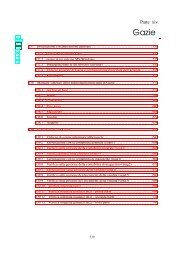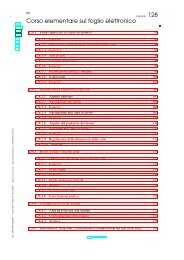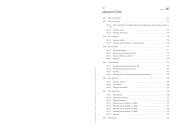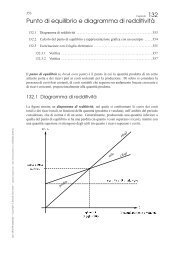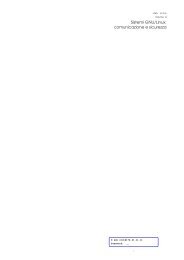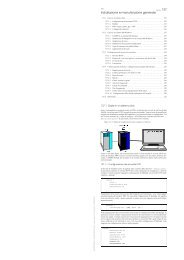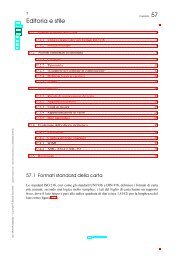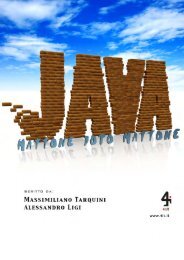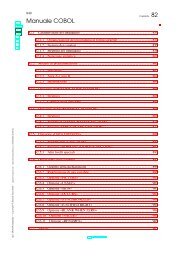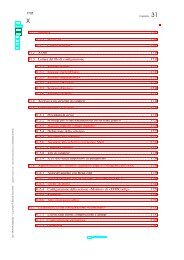Terminali a caratteri - IIS Marconi Latina - Area didattica
Terminali a caratteri - IIS Marconi Latina - Area didattica
Terminali a caratteri - IIS Marconi Latina - Area didattica
Create successful ePaper yourself
Turn your PDF publications into a flip-book with our unique Google optimized e-Paper software.
568 volume I Sistemi GNU/Linux: uso e amministrazione generale<br />
Rispetto alla macchina da scrivere, nella tastiera della telescrivente compaiono tasti con funzioni<br />
nuove, come il tasto [ Ctrl ] ( ), con lo scopo di produrre codici di controllo che non sono<br />
associati alla scrittura di alcun simbolo. Attualmente, la storia della telescrivente sopravvive<br />
nel codice ASCII.<br />
Generalmente, i codici di controllo necessari al funzionamento corretto delle comunicazioni<br />
attraverso una telescrivente sono generati quasi sempre attraverso combinazioni con un tasto,<br />
denominato control, con qualche eccezione eventuale per i codici più importanti, come per<br />
esempio ( ).<br />
Tradizionalmente, con la telescrivente, l’associazione del tasto control si rappresenta con un<br />
accento circonflesso, secondo una forma del tipo ‘^x’. Questa notazione rimane valida, purché<br />
utilizzata secondo il suo significato originale. In pratica, si deve considerare che le tastiere di<br />
un elaboratore comune si possono riconfigurare; pertanto, per fare un esempio, scrivere <br />
significa fare riferimento al codice ASCII 01 16 , pari a , ma non è detto, necessariamente,<br />
che per ottenere questo codice si debba premere sulla tastiera di oggi una combinazione del<br />
tipo [ Ctrl a ].<br />
|Tabella 15.12. Codici di controllo «C0», con la descrizione originale ottenuta da: C0<br />
control characters set, 1987, 〈http://www.itscj.ipsj.or.jp/ISO-IR/140.pdf 〉.<br />
Codice<br />
numerico<br />
Acronimo<br />
Combinazione<br />
tradizionale<br />
Nome<br />
0 16 NUL NULL<br />
1 16 SOH <br />
2 16 STX <br />
START<br />
HEADING<br />
START<br />
TEXT<br />
3 16 ETX END OF TEXT<br />
4 16 EOT <br />
OF<br />
OF<br />
END OF TRAN-<br />
SMISSION<br />
5 16 ENQ ENQUIRY<br />
6 16 ACK <br />
ACKNOWLED-<br />
GE<br />
Descrizione originale<br />
A control character used to accomplish<br />
media-fill or time-fill. NUL characters may<br />
be inserted into or removed from, a stream<br />
of data without affecting the information<br />
content of that stream, but such action may<br />
affect the information layout and/or the<br />
control of equipment.<br />
A transmission control character used as the<br />
first character of a heading of an information<br />
message.<br />
A transmission control character which precedes<br />
a text and which is used to terminate a<br />
heading.<br />
A transmission control character which<br />
terminates a text.<br />
A transmission control character used to indicate<br />
the conclusion of the transmission of<br />
one or more texts.<br />
A transmission control character used as a<br />
request from a remote station - the response<br />
may include station identification and/or station<br />
status. When a "Who are you" function<br />
is required on the general switched transmission<br />
network, the first use of ENQ after<br />
the connection is established shall have the<br />
meaning "Who are you" (station identification).<br />
Subsequent use of ENQ may, or may<br />
not, include the function "Who are you", as<br />
determined by agreement.<br />
A transmission control character transmitted<br />
by a receiver as an affirmative response to<br />
the sender.



